Entry Database : PDB / ID : 3gicTitle Structure of thrombin mutant delta(146-149e) in the free form Thrombin heavy chain Thrombin light chain Keywords / / / / / / / / / / / / / Function / homology Function Domain/homology Component
/ / / / / / / / / / / / / / / / / / / / / / / / / / / / / / / / / / / / / / / / / / / / / / / / / / / / / / / / / / / / / / / / / / / / / / / / / / / / / / / / / / / / / / / / / / / / / / / / / / / / / / / / / / / / / / / / / Biological species Homo sapiens (human)Method / / / / Resolution : 1.55 Å Authors Bah, A. / Carrell, C.J. / Chen, Z. / Gandhi, P.S. / Di Cera, E. Journal : J.Biol.Chem. / Year : 2009Title : Stabilization of the E* form turns thrombin into an anticoagulant.Authors : Bah, A. / Carrell, C.J. / Chen, Z. / Gandhi, P.S. / Di Cera, E. History Deposition Mar 5, 2009 Deposition site / Processing site Revision 1.0 Jun 2, 2009 Provider / Type Revision 1.1 Jul 13, 2011 Group / Version format complianceRevision 1.2 Nov 1, 2017 Group / Category Revision 1.3 Jul 29, 2020 Group Data collection / Database references ... Data collection / Database references / Derived calculations / Structure summary Category chem_comp / entity ... chem_comp / entity / pdbx_chem_comp_identifier / pdbx_entity_nonpoly / struct_ref_seq_dif / struct_site / struct_site_gen Item _chem_comp.name / _chem_comp.type ... _chem_comp.name / _chem_comp.type / _entity.pdbx_description / _pdbx_entity_nonpoly.name / _struct_ref_seq_dif.details Description / Provider / Type Revision 1.4 Sep 6, 2023 Group Data collection / Database references ... Data collection / Database references / Refinement description / Structure summary Category chem_comp / chem_comp_atom ... chem_comp / chem_comp_atom / chem_comp_bond / database_2 / pdbx_initial_refinement_model Item / _database_2.pdbx_DOI / _database_2.pdbx_database_accessionRevision 1.5 Nov 27, 2024 Group / Category / pdbx_modification_feature
Show all Show less
 Open data
Open data Basic information
Basic information Components
Components Keywords
Keywords Function and homology information
Function and homology information Homo sapiens (human)
Homo sapiens (human) X-RAY DIFFRACTION /
X-RAY DIFFRACTION /  SYNCHROTRON /
SYNCHROTRON /  MOLECULAR REPLACEMENT /
MOLECULAR REPLACEMENT /  molecular replacement / Resolution: 1.55 Å
molecular replacement / Resolution: 1.55 Å  Authors
Authors Citation
Citation Journal: J.Biol.Chem. / Year: 2009
Journal: J.Biol.Chem. / Year: 2009 Structure visualization
Structure visualization Molmil
Molmil Jmol/JSmol
Jmol/JSmol Downloads & links
Downloads & links Download
Download 3gic.cif.gz
3gic.cif.gz PDBx/mmCIF format
PDBx/mmCIF format pdb3gic.ent.gz
pdb3gic.ent.gz PDB format
PDB format 3gic.json.gz
3gic.json.gz PDBx/mmJSON format
PDBx/mmJSON format Other downloads
Other downloads 3gic_validation.pdf.gz
3gic_validation.pdf.gz wwPDB validaton report
wwPDB validaton report 3gic_full_validation.pdf.gz
3gic_full_validation.pdf.gz 3gic_validation.xml.gz
3gic_validation.xml.gz 3gic_validation.cif.gz
3gic_validation.cif.gz https://data.pdbj.org/pub/pdb/validation_reports/gi/3gic
https://data.pdbj.org/pub/pdb/validation_reports/gi/3gic ftp://data.pdbj.org/pub/pdb/validation_reports/gi/3gic
ftp://data.pdbj.org/pub/pdb/validation_reports/gi/3gic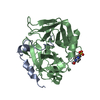
 Links
Links Assembly
Assembly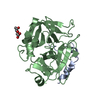
 Components
Components Homo sapiens (human) / Gene: F2 / Production host:
Homo sapiens (human) / Gene: F2 / Production host: 
 Homo sapiens (human) / Gene: F2 / Production host:
Homo sapiens (human) / Gene: F2 / Production host: 
 X-RAY DIFFRACTION / Number of used crystals: 1
X-RAY DIFFRACTION / Number of used crystals: 1  Sample preparation
Sample preparation SYNCHROTRON / Site:
SYNCHROTRON / Site:  APS
APS  / Beamline: 14-BM-C / Wavelength: 0.9002 Å
/ Beamline: 14-BM-C / Wavelength: 0.9002 Å molecular replacement
molecular replacement Processing
Processing MOLECULAR REPLACEMENT
MOLECULAR REPLACEMENT Movie
Movie Controller
Controller



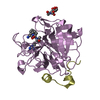

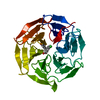
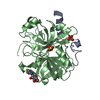
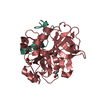
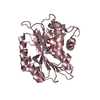
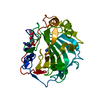
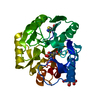
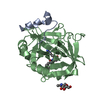
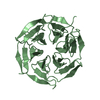
 PDBj
PDBj











